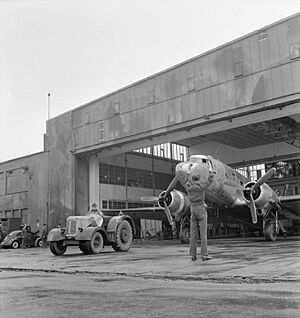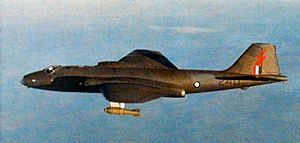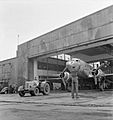David Evans (RAAF officer) facts for kids
Quick facts for kids
David Evans
|
|
|---|---|
| Birth name | Selwyn David Evans |
| Born | 3 June 1925 Paddington, New South Wales, Australia |
| Died | 2 September 2020 (aged 95) Canberra, Australian Capital Territory, Australia |
| Allegiance | Australia |
| Service/ |
Royal Australian Air Force |
| Years of service | 1943–1985 |
| Rank | Air Marshal |
| Unit |
|
| Commands held |
|
| Battles/wars | |
| Awards |
|
| Other work | Author; consultant |
Air Marshal Selwyn David Evans (born June 3, 1925 – died September 2, 2020) was a very important leader in the Royal Australian Air Force (RAAF). He was also a writer and advisor on defence. He served as the top commander of the Air Force, known as the Chief of the Air Staff, from 1982 to 1985. After leaving the RAAF, he wrote books about military topics and his own life story.
David Evans joined the Air Force in 1943 during World War II. He became a pilot and later an officer. From 1948 to 1949, he helped with the Berlin Airlift. This was a huge effort to fly supplies into West Berlin when the Soviet Union blocked all land routes. He also flew important people, like the Governor-General, earning him the Air Force Cross in 1957.
In the 1960s, Evans flew Canberra jet bombers. He was a leader in No. 2 Squadron during the Vietnam War from 1967 to 1968. His squadron was known for its very accurate bombing missions. For his excellent leadership in Vietnam, he received the Distinguished Service Order. Later, he became a high-ranking officer, helping to plan Australia's defence. He was made a Companion of the Order of Australia in 1984. After retiring in 1985, he continued to write and speak about defence.
Contents
Early Life and Becoming a Pilot
Selwyn David Evans was born in Paddington, a suburb of Sydney, Australia, on June 3, 1925. He was known by his middle name, David. As a boy, he loved reading about fighter pilots during the Battle of Britain. He decided he wanted to be a pilot when he grew up.
In 1941, he joined the Air Training Corps. This program helped young people aged 16 to 18 get ready to join the Royal Australian Air Force. After working briefly as a bank clerk, Evans joined the RAAF on June 5, 1943. He trained to be a pilot through a special program called the British Commonwealth Air Training Plan. He learned to fly at different schools across Australia.
After finishing his training, he became a sergeant pilot. In October 1944, he started working as a flying instructor. He was training to fly Bristol Beaufort bombers when World War II ended in August 1945. Many wartime soldiers were sent home, but Evans really wanted to stay in the Air Force. He managed to convince an officer to let him stay.
Flying Supplies in the Berlin Airlift
Soon after, Evans joined No. 38 Squadron. From October 1945 to May 1948, he flew C-47 Dakota transport planes. These planes carried mail and supplies to Japan regularly.
On March 3, 1947, he became a pilot officer. In August 1948, he married Dorothy (Gail) Campbell. They had to move their wedding forward because Evans was chosen for a special mission: the Berlin Airlift. He was promoted to flying officer and left for London on August 28.
He joined the RAAF Squadron Berlin Air Lift in Lübeck, West Germany. For the next 14 months, he flew over 250 missions in Royal Air Force Dakota planes. Flying in the Berlin Airlift was very difficult. Pilots had to fly using only their instruments, often in bad weather. Planes took off every three minutes, carrying vital supplies. Evans once had an engine fail right after takeoff with 23 passengers, mostly children, but he landed safely.
Instructor and VIP Pilot
When he returned to Australia in November 1949, Evans became a flying instructor. He taught new pilots for four years. This included a time when he worked with the Royal New Zealand Air Force. He was supposed to go to the Korean War, but the war ended before he could go.
In 1954, he started flying important people (VIPs). He worked with the Governor-General's Flight. His passengers included the Governor-General, Sir William Slim, and Prime Minister Robert Menzies. For his excellent service, he was awarded the Air Force Cross in 1957.
After this, he studied at the RAAF Staff College. He also worked for the Minister for Air, learning about Australian politics. In 1959, he trained to fly De Havilland Vampire and English Electric Canberra jet planes. From 1960 to 1962, he was a leader in No. 2 Squadron in Malaysia, flying Canberras. He then helped decide what kind of new bomber the RAAF needed. This led to Australia ordering the General Dynamics F-111C jet.
Vietnam War and Top Leadership
In April 1967, the Australian government sent No. 2 Squadron and its Canberra bombers to the Vietnam War. They flew missions from Phan Rang Air Base in Vietnam. Evans was promoted to wing commander and took command of the squadron in December 1967. He had never been in combat before and was eager to serve.
When he took command, the Canberras were flying more missions during the day. They used special methods to bomb very accurately. Evans worked hard to make their bombing even better. He allowed his pilots to bomb from the lowest possible height. This made the Canberras the most accurate bombing force in the area. In January 1968, his unit helped defend cities like Huế and Khe Sanh during the Tet Offensive. For his outstanding leadership, he received the Distinguished Service Order.
Leading the Air Force
In January 1969, Evans was promoted to group captain. He helped give some of the RAAF's old CAC Sabre planes to the Indonesian and Malaysian Air Forces. After studying in London, he became a top planner for the Air Force in 1973.
From 1975 to 1977, he was in charge of RAAF Base Amberley. Here, he learned to fly the new F-111C bomber and the UH-1 Iroquois helicopter. He was then promoted to air vice marshal and became the Chief of Air Force Operations. In this role, he worked on improving Australia's defence plans. He believed Australia should focus on stopping enemies far away, before they could reach Australian land.
In 1981, he was made an Officer of the Order of Australia for his work. He became the Chief of the Air Staff (the head of the Air Force) on April 21, 1982. As CAS, Evans focused on improving morale and making the Air Force stronger, especially in northern Australia. He was made a Companion of the Order of Australia in 1984.
He retired from the RAAF on May 30, 1985. He had flown over 8,600 hours during his career. His successor praised his "extraordinary zeal" and how he helped bring "a renewed sense of pride" to the Air Force.
After the Air Force
After retiring, David Evans became an advisor on defence and aviation. He wrote many articles and gave lectures about air power. In 1990, he published a book called A Fatal Rivalry: Australia's Defence at Risk. He also wrote War: A Matter of Principles in 2000.
He joined the board of British Aerospace Australia in 1990 and was a defence advisor until 2009. From 1997 to 2003, he was the chairman of the National Capital Authority. He also led the Royal United Services Institute Australia.
Evans was honored by the City of Berlin in 1998 for his part in the Berlin Airlift. In January 2001, he received the Centenary Medal for his service to Australia and the Canberra community. His autobiography, Down to Earth, was released in 2011.
David Evans passed away in Canberra in September 2020, at the age of 95.
Images for kids





